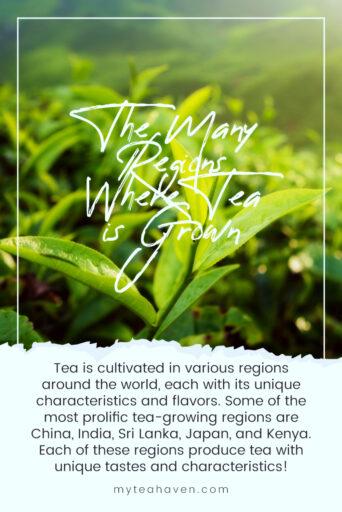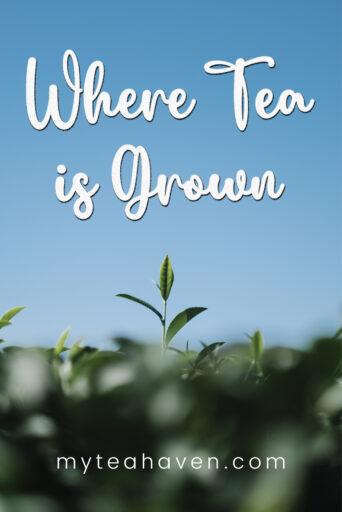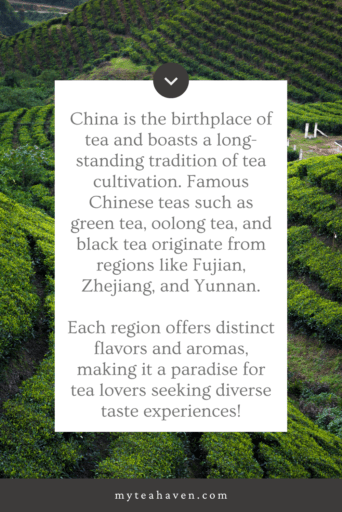A Sip of Adventure: Journeying to Where Tea Is Grown
Where is Tea Grown?
Today I will take you on a journey to the different tea growing regions! Whether you’re a tea connoisseur or simply curious about the fascinating world of tea, this article will help you get to know the fascinating tea growing regions better.
We are a participant in the Amazon Services LLC Associates Program, an affiliate advertising program designed to provide a means for us to earn fees by linking to Amazon.com and related sites. This post may contain affiliate links which means we may receive a commission, at no cost to you, for purchases made using our links. Please see my disclosure to learn more. Unless otherwise stated, all prices are in US$.

Grow Your Own Tea
The Complete Guide to Cultivating, Harvesting, and Preparing
Tea lovers, make a fresh pot, sit down with this delightful guide, and discover the joys of growing and processing your own tea at home. Tea farmer Christine Parks and enthusiast Susan Walcott cover it all from growing tea plants and harvesting leaves, to the distinct processes that create each tea’s signature flavors.

The Many Regions Where Tea is Grown
Tea is now cultivated in various regions around the world, each with its unique characteristics and flavors. Let’s take a closer look at some of the prominent tea growing regions:
China
China is the birthplace of tea and boasts a long-standing tradition of tea cultivation. Famous Chinese teas such as green tea, oolong tea, and black tea originate from regions like Fujian, Zhejiang, and Yunnan.
Each region offers distinct flavors and aromas, making it a paradise for tea lovers seeking diverse taste experiences!
India
India is renowned for its robust and flavorful teas and it’s home to several tea growing regions.
Darjeeling tea is grown in the misty hills of the Indian Himalayas, and it’s often referred to as the “Champagne of teas” due to its delicate and nuanced flavors. Assam, on the other hand, produces strong and malty black teas that are perfect for morning indulgence.

VAHDAM, Darjeeling Premium First Flush Black Tea
Darjeeling tea first flush, popularly known as the “Champagne of Teas”, has black tea leaves and captures the vibrancy of spring. This Darjeeling tea loose leaf has a bright golden liquor and leaves you wanting for more after every sip. Contrary to other Darjeeling tea, this black tea loose leaf is well balanced in strength and has low caffeine.
Sri Lanka
Formerly known as Ceylon, Sri Lanka is celebrated for its tea plantations nestled amidst picturesque landscapes. The island’s tropical climate and high elevations create the ideal conditions for producing exquisite black teas.
Ceylon tea is beloved for its bright, brisk flavors and is widely sought after by tea enthusiasts worldwide.
Japan
Japan is renowned for its unique tea-growing practices, most notably the cultivation of matcha and sencha teas.
Matcha is a powdered green tea, and is traditionally used in Japanese tea ceremonies. It’s highly prized for its vibrant green color and rich umami taste. Sencha, a steamed green tea, offers a refreshing and grassy flavor profile.

HANDPICK Organic Matcha Green Tea Powder
What sets matcha green tea apart from other types of tea is the way it is cultivated and processed. Matcha leaves are grown in the shade, which enhances their chlorophyll content, resulting in a vibrant green color and a rich, earthy flavor. The leaves are then carefully hand-picked and stone-ground into a fine powder, ensuring that every sip of the tea encapsulates its full essence.
Kenya
Kenya is located in East Africa and has emerged as a major player in the global tea market. The country’s favorable climate and fertile soils contribute to the production of robust black teas.
Kenyan teas are known for their bold flavors and are often used in blends to add depth and strength.
Factors Affecting Tea Growth
Several factors influence the growth and quality of tea. Let’s explore the key elements that contribute to the thriving tea plantations:
Climate
Tea thrives in regions with a moderate climate, with temperatures ranging from 13 to 30 degrees Celsius (55 to 86 degrees Fahrenheit). The ideal combination of warmth, rainfall, and humidity promotes healthy tea bushes and optimal leaf development.
Altitude
Altitude plays a crucial role in tea cultivation. Higher elevations tend to produce teas with more complexity and delicate flavors. The gradual change in temperature, along with the misty and cool mountain air, slows down the growth of the tea leaves, resulting in nuanced and exquisite teas.
Soil
Tea plants thrive in well-drained soils that are rich in organic matter. The composition of the soil, including its pH level and mineral content, significantly influences the flavor and character of the tea leaves. Different soil types contribute to the diverse flavor profiles found in teas from various regions.
The Best Tea Growing Regions

While each tea growing region has its charm, some regions stand out as the best for tea production.
These regions have the perfect combination of climate, altitude, and soil composition, resulting in exceptional teas.
When exploring tea growing regions, be sure to consider:
- Darjeeling, India: Experience the enchanting aroma and delicate flavors of the “Champagne of teas” in the misty hills of Darjeeling.
- Uji, Japan: Immerse yourself in the world of matcha and savor the vibrant green tea fields in Uji, known for producing the highest quality powdered green tea.
- Nuwara Eliya, Sri Lanka: Journey to the emerald tea gardens of Nuwara Eliya and indulge in the bright and brisk flavors of Ceylon tea.
- Yunnan, China: Explore the scenic tea plantations of Yunnan and discover the “birthplace of tea.”
- Nandi Hills, Kenya: Witness the picturesque landscapes of Nandi Hills in Kenya and taste the bold and robust black teas that the region is famous for.
A Few Final Thoughts
Tea is a beverage that connects people and cultures worldwide. Exploring the different tea growing regions allows us to appreciate the artistry and craftsmanship involved in creating a perfect cup of tea.
Whether you’re seeking delicate aromas or bold flavors, there is a tea growing region waiting to be discovered.
Embark on your tea journey and let your taste buds experience the wonders of the world of tea!


Growing Your Own Tea Garden
The Guide to Growing and Harvesting Flavorful Teas in Your Backyard
Growing Your Own Tea Garden is packed with inspiration and practical instructions for cultivating and enjoying delicious teas from a variety of plants in your own personal tea garden. You don’t have to be an avid gardener: Author Jodi Helmer, a food and farming journalist, provides all the information you need to plan and plant a healthy, bountiful backyard tea garden, with nine suggested garden designs and useful cultivation advice.
Some Questions You Might Have
- Are all teas grown in mountainous regions?
No, while some tea growing regions are situated in mountainous areas, there are also tea plantations in flat and hilly terrains. The geographical diversity contributes to the variety of teas available.
- Which tea growing region produces the most tea?
China is the largest tea producer globally, followed by India. These two countries have a long-standing history and tradition of tea cultivation.
- Can tea be grown in tropical regions?
Yes, tea can be grown in tropical regions. Sri Lanka, for example, has a tropical climate and is renowned for its tea plantations. The right combination of altitude and climate allows tea to thrive in these regions.
- Are there any other countries known for tea production?
Yes, several countries produce tea on a significant scale. Some notable tea-growing countries include Japan, Kenya, Taiwan, Turkey, and Vietnam.
- Can I visit tea plantations as a tourist?
Absolutely! Many tea-growing regions offer guided tours and tea tasting experiences for visitors. It’s a wonderful opportunity to learn about tea cultivation and immerse yourself in the beauty of tea gardens!








Comments are closed.